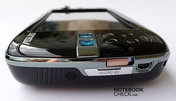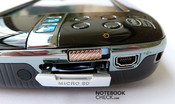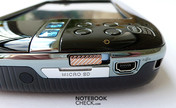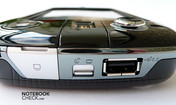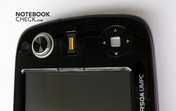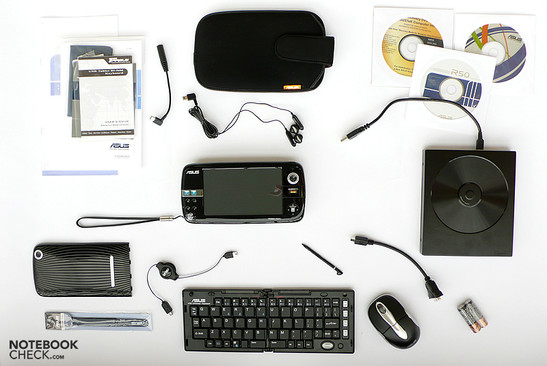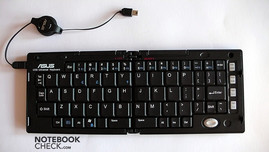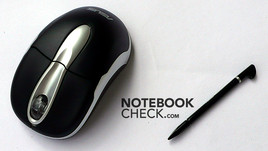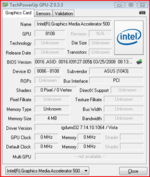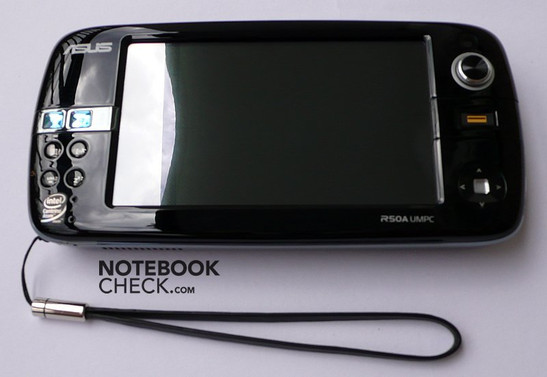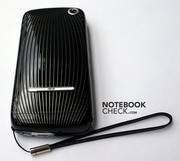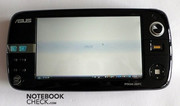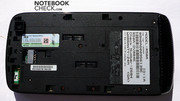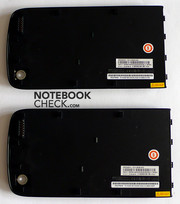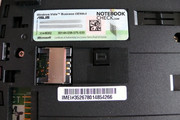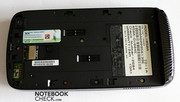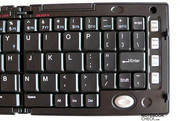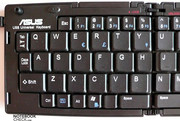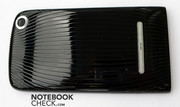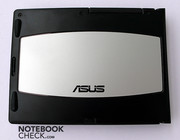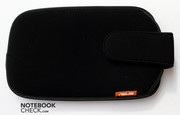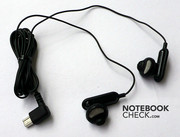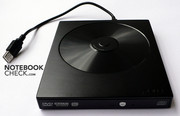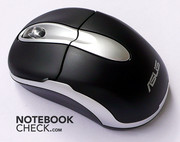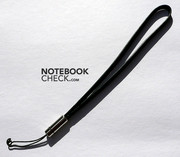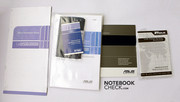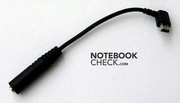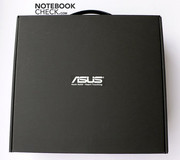Review of Asus R50A UMPC
Always at hand.
With the Asus R50A the Microsoft Origami project sends its greetings. Origami Experience 2.0 is a software package that is specifically designed for Ultra-Mobile PCs by Microsoft. Based on Windows Vista, this allows ad-hoc access to required information on the go. The included WWAN 3G HSDPA module and GPS also matches the mobile communications character. All together the successor of the Asus R2H, and competitor of the Samsung Q1 Ultra, provides modern technologies, several useful features, and a navigation system in a pocket sized format.
We would like to thank our Polish colleagues from notebookcheck.pl, who carried out the test and provided us with this review.
Case
The design of the R50A immediately appealed to us. Despite the fact that it is made of plastic, it still leaves a high quality impression. With the black high-gloss surfaces and the chrome-colored bar along the edges its a real eyecatcher. Unfortunately fingerprints and signs of use are easily visible, and quickly accumulate on these. Besides the actual function of the included protective cover, which is to protect the device from damage during transport, it also cleans the R50A every time it is removed, due to the structure of the inner lining.
Because of its size of only 199 mm wide, 97 mm long, and 28.4 mm deep, the R50A has plenty of space in the palm of a hand. In cargo-trousers it could even be tucked away in a trouser pocket, however it is anything other than comfortable walking around in this fashion with an additional weight of 520 grams on one side. In contrast it is by far more pleasant to carry it in the hand while doing so. With the leather wrist strap, arbitrarily hung around the left or right wrist, the device can be safeguarded against accidentally being dropped.
Accessories
Asus shows itself generous with respect to accessories. As standard these include a protective case, an anti-reflex cover for the screen, a VGA adaptor, and headphones with an adaptor. Optionally available are a Bluetooth mouse, car accessories, and also an external DVD+-R/RW/RAM drive with lightscribe function.
The same applies to the software supplied. Alongside diverse Asus utilities, Norton Internet Security 2008, Adobe Acrobat Reader 8.0, and Power2Go are also pre-installed.
Connectivity
Due to the limited space available, it was obviously necessary to make some compromises with regard to the number and size of the interfaces. Thus, next to a single standard-USB 2.0 port, there are for example also two mini-USB ports on offer. External displays can be connected with the help of the included mini-VGA output adaptor. Unfortunately the integrated card reader can only read micro-SD cards (Trans Flash).
A positive aspect are the wireless communication capabilities. Bluetooth 2.0+EDR for communication with devices and wireless-LAN are available. Although the integrated WLAN module only supports the standards b and g.
Additionally there is also GPS alongside an integrated 3G modem (up to 700kB/s transfer rate), the SIM-slot to which can be found under the battery. For better signal reception Asus has also provided an external antenna for the former. In the open several satellite signals can be received with the GPS module without problems. In addition it is possible to follow routes without difficulties, due to the relatively quickly updated images, thanks to the comparatively powerful processor and the relatively large and clear screen, compared to other Pocket PCs or Windows-Mobile-Navigation-Units. One interesting feature is also the possibility to Geo-Tag pictures, which have been taken with either of the two integrated cameras, by applying geographic reference information to their metadata.
On the subject of both built-in cameras. The first is located in the upper right corner, immediately above the thumb-joystick mouse. This one is primarily useful for internet telephony. The second, with 2MP sensor, is located on the back.
Input Devices
Although there are optionally a double foldable keyboard with retractable USB cable, and a Bluetooth mouse, it is highly unlikely that one would want to carry these around additionally when in the field. Moreover even when folded together the keyboard is still quite big. Apart from that, we couldn't get used to the rubbery surface of the keys and their unconventional size. In comparison we preferred the sliding keyboard in the Sony Vaio UX, with which a small backlit keyboard emerges when both halves of the enclosure are pulled apart, or also the sliding keyboard in the OQO Model 2+.
Therefore the main user interface is still the touchscreen. This should preferably by used with the stylus and not with the finger, since this circumvents making the screen dirty and increases the precision of commands. Nevertheless it proves to be difficult to work accurately with such a tiny stick, for example in juddering vehicles.
It is hence likely that users will resort to using the thumb-joystick mouse located in the right upper corner, for operation of the mouse cursor. With this the mouse cursor can be moved in 16 different directions. To its right are located the left (L-button) and right mouse buttons (R-button), which are operated with the users left thumb. On the other side the D-pad (Directional Pad) is located, with which it is possible to steer into four directions and operate the square enter key in the middle.
Alongside these the R50A provides a row of additional keys. The four on the left side provide functions such as energy options, DVD player, lock and standby mode. Unfortunately their arrangement proves not to be ideal, so that it is possible to inadvertently activate these with the left palm occasionally.
Equally the fingerprint reader has acquired a rather unfavorable place. This can also easily be activated accidentally while navigating with the neighboring controllers. Fortunately it can also be deactivated, so that this can be avoided.
Display
Unfortunately the shiny surface of the built-in 5.6 inch display makes it almost impossible to recognize anything under direct sunlight. Although with the use of the included anti-reflex foil this can be partially mastered.
Furthermore the situation is improved somewhat in the shade. And the color representation of the 1024x600 display is quite satisfying.
With regard to the viewing angle, it can only be said that this could be better. But since Asus will most likely use the AMOLED technology (Active Matrix Organic Light Emitting Diode) for the next generation of the R50A, this problem will thereby solve itself.
Performance
Due to the other features and the conception of the Asus R50A, it cannot really be compared to Netbooks. Although a comparison of the benchmark results with Netbooks of the same hardware configuration also delivers a sold impression. Compared with similar devices geared towards ultra-mobile-computing, the advantage in performance is obvious.
The Asus R50A is based on the Menlow platform by Intel. Equipped with an Atom Z520 processor with 512 KB L2 Cache, which can operate at a maximum speed of 1.33 GHz, and the Thermal Design Power (TDP) only amounts to two Watts. With the use of Intels Enhanced SpeedStep Technology, it is possible to reduce the processing speed. The minimum power consumption of this CPU amounts to 100 mW, although on average 200 mW are not exceeded.
Although the Atom Z520 processor only possesses a single core, it can emulate a second core with the use of Hyper-Threading technology. Moreover it also supports the Intel Virtualization Technology (VT), which is particularly interesting for all those that plan to implement Windows 7 in XP mode.
Concerning the 3DMark results, the Asus R50A achieved 1335 points in 2001SE and 142 points in the 2003 version. In the Geekbench test it made it to 702 points.
The RAM capacity of one Gigabyte in combination with the pre-installed version of Windows Vista does appear a bit sparse. With with this the memory is already 75% utilized with a few simple applications. By means of a downgrade to Windows XP, or by choice of a Linux distribution, for example Ubuntu Mobile Internet Device Edition, it is possible to ameliorate this issue, and provide more resources for applications.
The built-in 1.8 inch SSD was tested by means of the tool HDTune. And we were a little disappointed with the maximum transfer rate of not even 50MB/s. With an access time of 0.3 milliseconds, it does however bring a few advantages in comparison to usual hard drives.
| 3DMark 2001SE Standard | 1335 points | |
| 3DMark 03 Standard | 142 points | |
Help | ||
Emissions
System Noise
The Asus R50A is practically inaudible when is use. Only in extremely quiet surroundings is it potentially possible to perceive the quiet hum of the fan.
Temperature
Only under a high workload does heating of the case take place. Luckily the temperature level stays within the acceptable range at all times, so the device can be held for prolonged periods of time.
Loudspeakers
Clear sound and good volume are provided by the integrated loudspeakers, so that it is definitely possible to enjoy listening to music or Internet radio. The included Turbo-Bass headphones also reach achieve a decent sound quality, and are on a level with other high quality models by Sony, and even outperform the headphones supplied with Apple iPods.
Battery Life
The Asus R50A is delivered with two Lithium-Ion batteries, of which each one provides a capacity of 2600mAh. One of these is discharged after approximately 3 hours of internet surfing over WLAN, if the economy power profile is used. In the high performance profile only approximately two hours and 20 minutes are achievable. Considering that power saving components and a power saving SSD disk drive are built-in, a better battery life would be expected.
Also desirable would be an external charger, with which one battery could be charged, while the other is being used.
Verdict
The Asus R50A proves to be a thought-out device for on the go. Its various features can be applied meaningfully according to the requirements of the user at particular points in time.
Especially the wireless communications capabilities impressed us. With a 3G module and WLAN it is possible to access the Internet in many locations. In case of getting lost, the GPS module leads the way home, or wherever else the user might want to go.
All this fits, just like a Smartphone, into a trouser pocket. Altogether you might ask yourself why the R50A is not touted as one of the hot tips by mobile network operators.


 Deutsch
Deutsch English
English Español
Español Français
Français Italiano
Italiano Nederlands
Nederlands Polski
Polski Português
Português Русский
Русский Türkçe
Türkçe Svenska
Svenska Chinese
Chinese Magyar
Magyar











